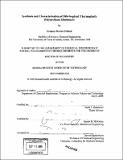Synthesis and characterization of silk-inspired thermoplastic polyurethane elastomers
Author(s)
Pollock, Gregory S
DownloadFull printable version (15.33Mb)
Other Contributors
Massachusetts Institute of Technology. Dept. of Chemical Engineering.
Advisor
Paula T. Hammond.
Terms of use
Metadata
Show full item recordAbstract
Segmented polyurethane elastomers containing additional ordered structures within the hard or soft domains were developed to mimic the hierarchical structure and superior properties observed in spider silk fibers. The silk's toughness is related to a fiber morphology that includes P-pleated crystalline sheets within an amorphous matrix, as well as an additional interphase with an orientation and mobility between that of the two microphases. In the polyurethane mimics, bulky aromatic diisocyanates were incorporated between aliphatic hexamethylene diisocyanate (HDI) hard segments and poly(tetramethylene oxide) (PTMO) soft segments, to enhance the size and orientation of the interphase. The mixture of diisocyanates reduces the crystallinity of the HDI hard segments, allowing the polyurethane to form more well-organized domains observed by AFM imaging. The more interconnected hard domains allow the elastomers to deform to higher elongations and absorb more energy without a decrease of initial modulus. Shearing of the hydrogen-bonded hard domains orients the hard blocks at a preferred tilt angle of ±20⁰ from the strain direction during tensile deformation. (cont.) While the average spacing of hard domains increases during deformation, the spacing of hard domains aligned with the strain decreases, and the spacing of hard domains at the preferred tilt angle remains constant. Strain-induced crystallization of the PTMO soft segments was observed in all samples; however, hard segments with mixed diisocyanates exhibited non-crystalline alignment of the hard domains. Several polyurethane nanocomposite structures were also created using particles that preferentially associate with hard or soft segments. HDI-PTMO polyurethane/Laponite nanocomposites provided modest mechanical property improvements (80% increase in modulus and 15% increase in toughness) without any loss of extensibility. The Laponite discs exhibited an exfoliated structure, associating with and reinforcing the hydrophilic polyurethane hard segments. HDI-PTMO polyurethane/MQ siloxane resin nanocomposites also exhibited particle association with the hard segments, providing a 60% increase in modulus with a small loss of toughness. (cont.) However, composites of isobutyl-POSS dispersed in polyurethanes with mixed hard segments exhibited formation of POSS crystals associated with the soft segments at all loadings, resulting in tensile failure at strains 80-100% lower than the pure polyurethane.
Description
Thesis (Ph. D.)--Massachusetts Institute of Technology, Dept. of Chemical Engineering, 2005. Includes bibliographical references.
Date issued
2005Department
Massachusetts Institute of Technology. Department of Chemical EngineeringPublisher
Massachusetts Institute of Technology
Keywords
Chemical Engineering.